HP HPE6-A48 Aruba Certified Mobility Expert 8 Written Exam Online Training
HP HPE6-A48 Online Training
The questions for HPE6-A48 were last updated at Apr 16,2025.
- Exam Code: HPE6-A48
- Exam Name: Aruba Certified Mobility Expert 8 Written Exam
- Certification Provider: HP
- Latest update: Apr 16,2025
A bank deploys an Aruba Mobility Master (MM)-Mobility Controller (MC) solution to provide wireless access for users that run different applications on their laptops, including SIP-based IP telephony. When users only run the IP telephony software, call quality is high.
However, if users also run email, web, or mission critical applications, then voice quality drops.
Which feature would help improve the quality of voice calls over the air when users run different applications?
- A . DSCP for IPv4 traffic
- B . WiFi Multi Media
- C . Type of Service
- D . High/Low Queue
A point venture between two companies results in a fully functional WLAN Aruba solution. The network administrator uses the following script to integrate the WLAN solution with two radius servers, radius1 and radius2.
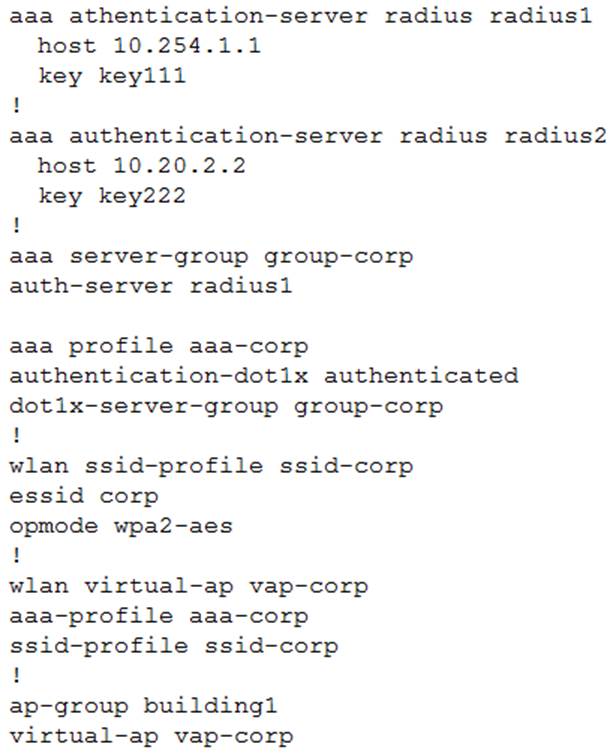
While all users authenticate with [email protected] type of credentials, radius1 has user accounts without the domain name portion.
Which additional configuration is required to authenticate corp1.com users with radius1 and corp2 users with radius2?
- A . aaa authentication-server radius radius1
trim-fqdn
!
aaa server-group-corp
auth-server radius1 match-authstring corp1.com
auth-server radius1 match-authstring corp2.com - B . aaa server-group-corp
auth-server radius1 match-fqdn corp1.com
auth-server radius1 trim-fqdn
auth-server radius2 match-fqdn corp2.com - C . aaa authentication-server tadius radius1
!
aaa server-group-corp
auth-server radius1 match-string corp1.com trim-fqdn
auth-server radius1 match-string corp2.com - D . aaa authentication-server radius radius1
trim-fqdn
!
aaa server-group-corp
auth-server radius1 match-domain corp1.com
auth-server radius1 match-domain corp2.com
A network administrator implements a SIP-based IP telephone solution. The objective is to ensure that APs use 100% of their airtime for network access whenever a voice call is taking place, to minimize communication delays. The network administrator also wants to ensure that a log entry is generated when voice calls occur.
Which setup accomplishes these tasks?
- A . ip access-list session voice
user any svc-rtsp permit log queue high
user any svc-sip-udp permit log queue high - B . ip access-list session voice
user any-svc-rtsp permit disable-scanning log
user any svc-sip-udp permit disable-scanning log - C . ip access-list session voice
user any svc-rtsp permit log dot1p-priority 7
user any svc-sip-udp permit log dot1p-priority 7 - D . ip access-list session voice
user any svc-rtsp permit log tos 56
user any svc-sip-udp permit log tos 56
Refer to the exhibits.
Exhibit1

Exhibit2
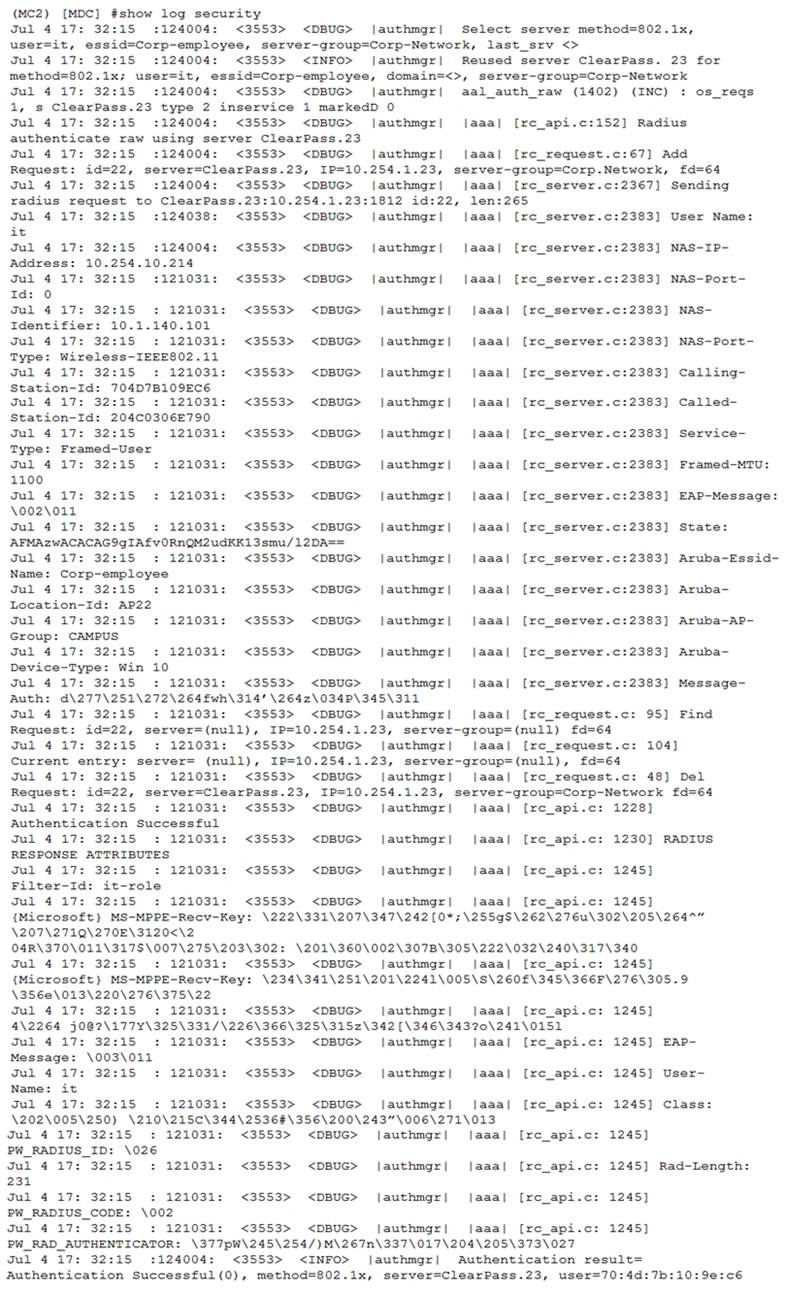
A network administrator integrates a current Mobility Master (MM)-Mobility Controller (MC) deployment with a RADIUS infrastructure. After using the RADIUS server to authenticate a wireless user, the network administrator realizes that the client machine is not falling into the it_department role, as shown in the exhibits.
Which configuration is required to map the users into the proper role, based on standard attributes returned by the RADIUS server in the Access Accept message?
- A . aaa server-group Corp-Network
set role condition Filter-Id equals it-role set-value it_department - B . aaa server-group GROUP-RADIUS
set role condition Filter-Id equals it-role set-value it_department - C . aaa server-group Corp-employee
set role condition Filter-Id equals it-role set-value it_department - D . aaa server-group Corp-employee
set role condition Filter-Id value-of
Refer to the exhibits.
Exhibit 1
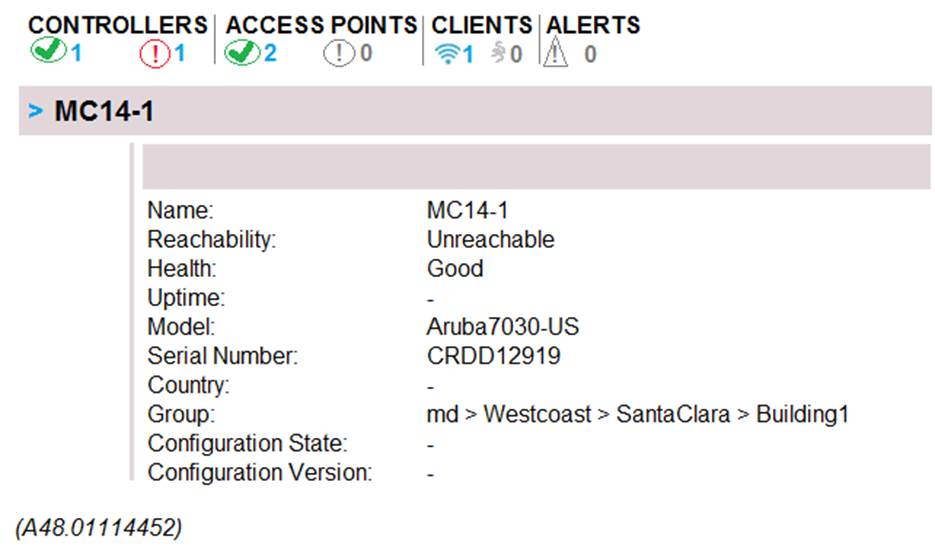
Exhibit 2
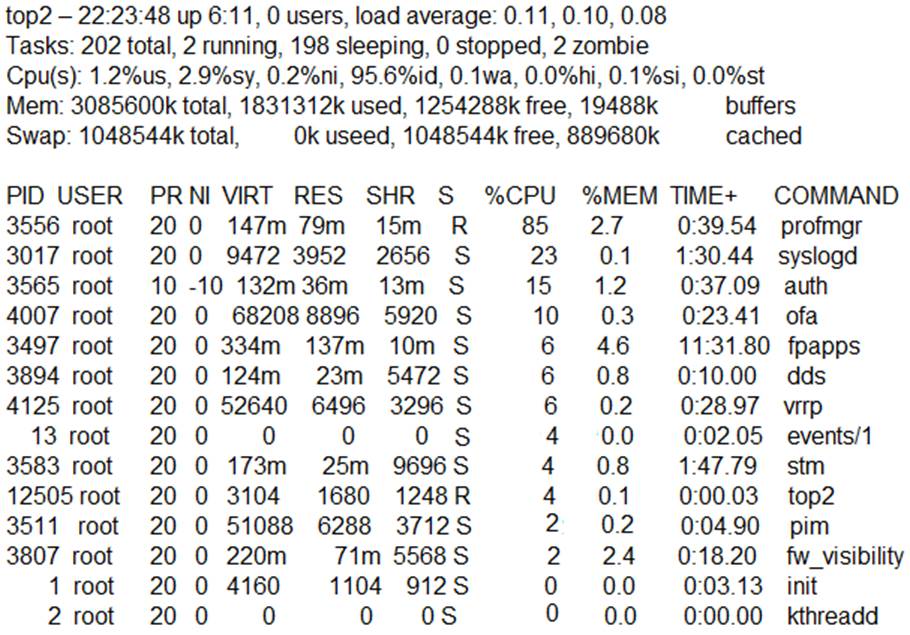
A network administrator adds a new Mobility Controller (MC) to the production Mobility Master (MM) and deploys APs that start broadcasting the employees SSID in the West wing of the building. Suddenly, the employed report client disconnects.
When accessing the MM the network administrator notices that the MC is unreachable, then proceeds to access the MC’s console and obtains the outputs shown in the exhibits.
What should the network administrator do next to solve the current problem?
- A . Decommission the MC from the MM, and add it again.
- B . Open a TAC case, and send the output of tar crash.
- C . Verify the license pools in the MM.
- D . Kill two zombie processes, then reboot the MC.
Refer to the exhibit.

A network administrator adds a Mobility Controller (MC) in the /mm level and notices that the device does not show up in the managed networks hierarchy. The network administrator accesses the CLI, executes the show switches command, and obtains the output shown in the exhibit.
What is the reason that the MC does not appear as a managed device in the hierarchy?
- A . The network administrator added the device using the wrong Pre=shared Key (PSK).
- B . The digital certificate of the MC is not trusted by the MM.
- C . The IP address of the MC does not match the one that was defined in the MM.
- D . The network administrator has not moved the device into a group yet.
Refer to the exhibit.
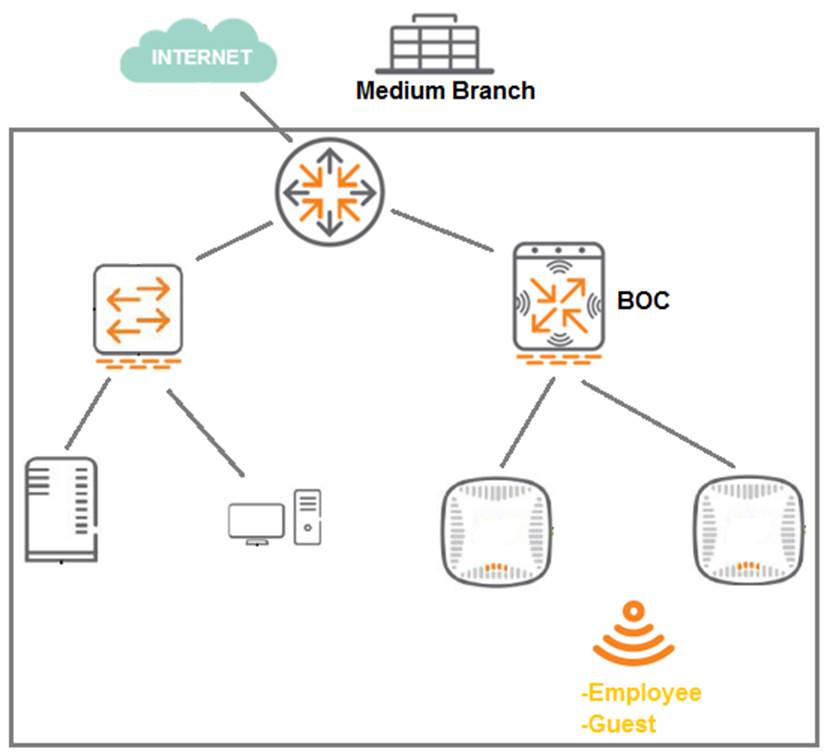
A 7008 Branch Office Controller (BOC) is deployed in a remote office behind a core router. This core router does not support 802.1q encapsulation. The Mobility Controller (MC) is the gateway for two tunneling mode SSIDs, as shown in the exhibit.
Which two different configuration options ensure that wireless users are able to reach the branch network through the router? (Select two.)
- A . Configure all ports of the BOC as access ports on the controller VLAN, and change the gateway of clients to the core router IP.
- B . Configure the uplink of the BOC as an access port on the controller VLAN, and enable NAT for the SSID VLANs.
- C . Configure the uplink of the BOC as a trunk port, tagging the controller and the SSID VLANs, and enable NAT for the SSID VLANs.
- D . Configure the uplink of the BOC as an access port on the controller VLAN, and add static router in the
router for the SSID VLAN subnets. - E . Configure the uplink of the BOC as a trunk port that permits the controller and the SSID VLANs. The
controller VLAN must be native.
Refer to the exhibit.
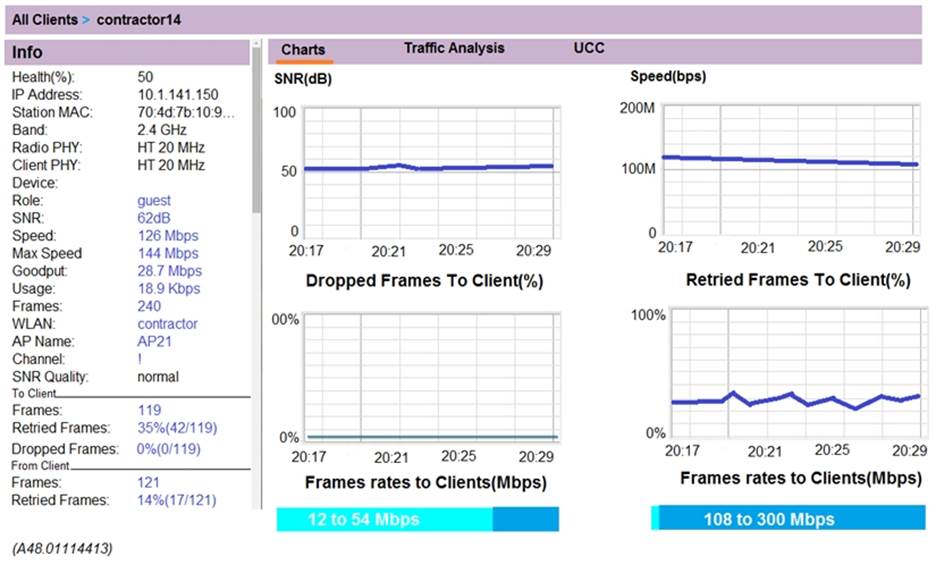
A user reports show response time to a network administrator and suggests that there might be a problem with the WLAN. The user’s laptop supports 802.11n in the 2.4 GHz band only. The network administrator finds the user on the Mobility Master (MM) and reviews the output shown in the exhibit.
What can the network administrator conclude after analyzing the data?
- A . Client health is low, and retried frames are high. It is possible there is high channel utilization.
- B . Client health is low, but SNR is high. It is possible data in the dashboard is not accurate and needs to be updated.
- C . The speed is good. Client health seems to be related to a problem with the client NIC.
- D . The network is low because of low SNR. TX power must be increased in both the client and the AP.
Refer to the exhibit.

A user reports show response time to a network administrator and suggests that there might be a problem with the WLAN. The user’s laptop supports 802.11n in the 2.4 GHz band only. The network administrator finds the user on the Mobility Master (MM) and reviews the output shown in the exhibit.
What can the network administrator conclude after analyzing the data?
- A . Client health is low, and retried frames are high. It is possible there is high channel utilization.
- B . Client health is low, but SNR is high. It is possible data in the dashboard is not accurate and needs to be updated.
- C . The speed is good. Client health seems to be related to a problem with the client NIC.
- D . The network is low because of low SNR. TX power must be increased in both the client and the AP.
Refer to the exhibit.

A user reports show response time to a network administrator and suggests that there might be a problem with the WLAN. The user’s laptop supports 802.11n in the 2.4 GHz band only. The network administrator finds the user on the Mobility Master (MM) and reviews the output shown in the exhibit.
What can the network administrator conclude after analyzing the data?
- A . Client health is low, and retried frames are high. It is possible there is high channel utilization.
- B . Client health is low, but SNR is high. It is possible data in the dashboard is not accurate and needs to be updated.
- C . The speed is good. Client health seems to be related to a problem with the client NIC.
- D . The network is low because of low SNR. TX power must be increased in both the client and the AP.
Latest HPE6-A48 Dumps Valid Version with 61 Q&As
Latest And Valid Q&A | Instant Download | Once Fail, Full Refund

